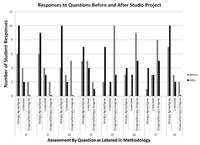Fusion of Teaching and Research: Design Support Tools and Vegetated Walls

At Virginia Tech, students were given a two-week project in the second-year studio and asked to use vegetated assemblies. Their work was reviewed in relation to what types of representation and methods supported their design decision-making.
The purpose was to see what and how students design when using vegetated assemblies and what tools or technologies they chose to represent ideas and make decisions. This was done to confirm that the targeted programs for use in a future prototype tool were in fact the programs students used. The results from the survey statements showed that a professor’s knowledgebase influenced the student’s comprehension and, with exposure to topics, students were more likely to include topics in future work and develop distinctive representational styles and methods. The envisioned tool will help inform designers, but not make decisions for them. This initial research refined assumptions made about programs to target in the prototype tool and confirmed a self-identified student need for a tool.
keywords: Architecture, Design Research, Research, Student Research, Vegetated Assemblies


Add comment
Log in to post comments